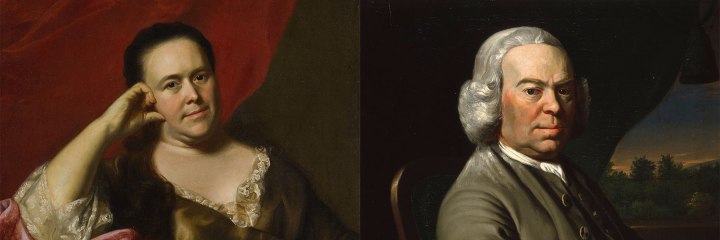Unknown to the seller, at least at first, the museum already owned Copley’s matching portrait of Scollay’s husband, John Scollay (1712-1790).
Here’s the backstory recounted by Enfilade, the newsletter of the Historians of Eighteenth-Century Art & Architecture:
Completed in 1763, Mrs. Scollay’s portrait demonstrates Copley’s talents and abilities as a painter as evidenced through the beautifully rendered fabric draped around the sitter.To celebrate the Scollays’ reunion on canvas and explore that acquisition, the director of the Shelburne Museum, Tom Denenberg, delivered an online talk which is now available on the museum’s website and Facebook page.
Shelburne Museum founder Electra Havemeyer Webb assembled the American paintings collection with the intention of juxtaposing well-known artists such as Copley with lesser-known itinerant or ‘folk’ painters. She purchased the portrait of John Scollay from Harry Shaw Newman at the Old Print Shop in New York City in 1959. The Museum’s extensive collection of American paintings tell a story about how the fine arts developed and came of age in the United States, and the reunion of these pendants continues to enrich the narrative.
Denenberg’s talk might overstate Scollay’s political activity in a couple of directions. He was a member of the Boston merchants who often opposed Parliament’s new revenue laws and he served many years as a selectman, including during the siege of Boston. In that way Scollay was a “Son of Liberty,” but we shouldn’t view him as a radical; he was part of the establishment. In addition, as chair of the selectmen he was merely first among equals, not equivalent to a mayor.
The most distinct aspect of Scollay’s political career, I think, is how he was a selectman from 1754 to 1764 and then from 1772 to 1790. Why the break? Because he was caught up in the financial failure of Nathaniel Wheelwright in 1765 and had to declare bankruptcy and rebuild his estate. The fact that he succeeded and was able to return to the selectmen as the board’s senior member reflects how his neighbors must have respected him.
Copley produced another pair of portraits of the Scollays as well, in pastel instead of oil. That picture of Mercy Scollay is at the Harvard Art Museums, the picture of John at the Pennsylvania Academy of Fine Arts.

And of course we can't forget John Scollay's significance in the development of Boston place names. He owned a block of buildings at the junction of Tremont Street and Queen [later Court] Street that became known as Scollay's Buildings. During the 19th century that narrow block of buildings impeded traffic, so they were demolished and the resulting open space became known as Scollay Square.
ReplyDeleteDenenberg mentioned Scollay Square in his talk but gave all the credit to John and Mercy’s son, who oversaw the next stage of development.
ReplyDeleteI enjoyed a show at The Old Howard before it burned in 1961. Would have been nice if Scollay Square had been preserved.
ReplyDelete